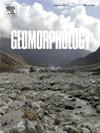Pervasive speleogenetic modification of cave passages by nitrification of biogenic ammonia
IF 3.1
2区 地球科学
Q2 GEOGRAPHY, PHYSICAL
引用次数: 0
Abstract
It has long been known that guano deposits from animals in caves can cause localised biogenic modification through a combination of acidity and altered environmental conditions, such as increased humidity and CO2. Geomorphological and geochemical evidence from the caves in the Gunung Mulu National Park, Sarawak, suggest this biogenic overprint may be far more widespread than previously thought due to microbial metabolic activity. Based on our observations, we propose a novel method of secondary cave enlargement by the conversion of highly soluble ammonia gas released by bat and swiftlet guano to NOx on surfaces by microbial ammonia oxidation. Our data suggest this activity produces aggressive nitric acid solutions on moist cave walls, accelerating limestone dissolution. This previously undescribed cave enlargement process has potentially profound geomorphological implications, as the original passage morphologies (which are used to interpret speleogenesis and landscape evolution) are erased and replaced with a distinctive suite of biogenic corrosion features. Such findings significantly alter our understanding of post-speleogenetic modification and secondary enlargement of caves in tropic environments.

生物氨硝化作用对洞穴通道的普遍改造
人们早就知道,洞穴中动物的鸟粪沉积物可以通过酸度和改变的环境条件(如湿度和二氧化碳的增加)的组合引起局部生物修饰。沙捞越古农木鲁国家公园洞穴的地貌和地球化学证据表明,由于微生物代谢活动,这种生物叠印可能比以前认为的要广泛得多。在此基础上,我们提出了一种利用微生物氨氧化将蝙蝠和金丝燕粪便释放的高可溶性氨气转化为氮氧化物的二次扩洞新方法。我们的数据表明,这种活动在潮湿的洞穴壁上产生了腐蚀性的硝酸溶液,加速了石灰岩的溶解。这种先前未被描述的洞穴扩大过程具有潜在的深刻地貌学意义,因为原始通道形态(用于解释洞穴形成和景观演化)被抹去,取而代之的是一套独特的生物侵蚀特征。这些发现极大地改变了我们对热带环境中洞穴后进化改造和二次扩大的理解。
本文章由计算机程序翻译,如有差异,请以英文原文为准。
求助全文
约1分钟内获得全文
求助全文
来源期刊

Geomorphology
地学-地球科学综合
CiteScore
8.00
自引率
10.30%
发文量
309
审稿时长
3.4 months
期刊介绍:
Our journal''s scope includes geomorphic themes of: tectonics and regional structure; glacial processes and landforms; fluvial sequences, Quaternary environmental change and dating; fluvial processes and landforms; mass movement, slopes and periglacial processes; hillslopes and soil erosion; weathering, karst and soils; aeolian processes and landforms, coastal dunes and arid environments; coastal and marine processes, estuaries and lakes; modelling, theoretical and quantitative geomorphology; DEM, GIS and remote sensing methods and applications; hazards, applied and planetary geomorphology; and volcanics.
 求助内容:
求助内容: 应助结果提醒方式:
应助结果提醒方式:


